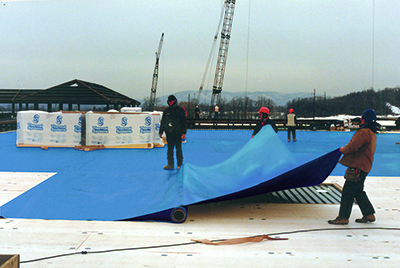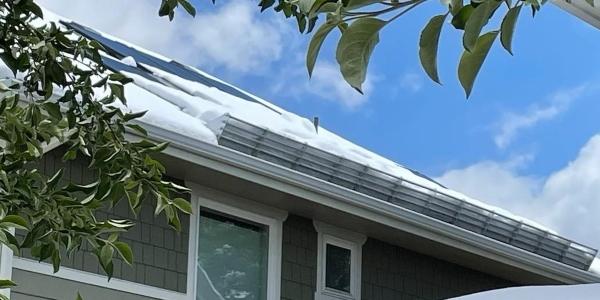Blue Roof to the Rescue

When Hurricane Irma slammed into Florida in September of 2017, it hit Marco Island and Ft. Myers hard.
Most buildings suffered serious wind damage, and many roofs were damaged or destroyed. It has kept roofers very busy with some repairs not receiving attention until recently.
Thousands of metal, tile, flat and shingled roofs lost integrity and needed immediate repairs. To prevent further harm to the affected homes and businesses, roofers installed various temporary solutions to protect the buildings until permanent repairs could be completed. Most roofers turned to temporary options which only held up for a few months.
Time becomes a factor
Unfortunately, the breadth of the destruction meant that roofers simply could not work fast enough to make timely repairs to all the damaged roofs.
The temporary options contractors were using — designed to protect for relatively brief periods — began to fail and require recoating after months of exposure to harsh Florida weather. With no manpower to make permanent repairs quickly, roofers faced a dilemma.
The insurance conundrum
Some membranes may last up to six months, but it’s taking as much as 18-24 months to resolve insurance claims related to Irma. Insurance won’t cover the cost of re-drying, so on larger jobs, it was especially important to find alternatives. Some of the most experienced roofers in the state turned to FiberTite® Blue Roof™, a temporary membrane designed to protect a variety of roofs, including low or steep slopes.
Alternative roofing membrane options could require multiple replacements until repairs can be made. Most insurance won’t pay for redoing temporary roofs if the material is failing. Owners would either have to coat the original material for the lower cost or pay to replace it.
The Blue Roof Advantage
FiberTite Blue Roof is an exceptionally strong and long-lasting membrane that can provide UV resistance and protection for up to a year or more. It has good resistance to abrasion, tears and punctures.
“The cost is very reasonable given the time it lasts and its effectiveness,” said Tracy Buis of Colonial Roofing. “I especially like how easy it is to work with. It can conceal all attachments on a roof, which is vital for durability and leak prevention. It also gives you more options than most products and it buys time until a comprehensive repair can be done.”
Over the course of a 30-year roofing career, Buis has worked with just about every option and has decades of field experience with both FiberTite and many other single-ply products.
“In Florida, we have lots of UV rays to go along with saltwater, tornadoes, hurricanes and other heavy weather,” said Buis. “No other dry-in lasts a year like FiberTite Blue Roof in this environment. And it doesn’t just last — it’s easy to work with and chemically resistant.”
Buis also likes Blue Roof’s reliability, part of which comes from how it installs. Blue Roof installs similarly to permanent materials. Roofers can use 8-foot sheets and simply mechanically attach it. Concealed fasteners required by other options need sealant and are prone to leaking. Blue Roof works like a conventional roofing material, is 100% watertight and won’t detach.
To learn more, download the FiberTite Blue Roof sell sheet.
Editor’s note: This article first appeared on FiberTite’s blog and can be viewed here.






















Comments
Leave a Reply
Have an account? Login to leave a comment!
Sign In